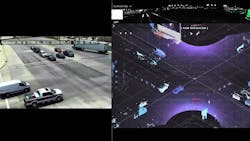Utah DOT Deploys LiDAR Technology at Key Intersections
New technology the Utah Department of Transportation (UDOT) is implementing at intersections across the state will help determine where problems exist in intersections so engineers can remedy them.
The LiDAR technology is promising to “revolutionize” how traffic engineers identify and address potential hazards for pedestrians, cyclists, and motorists alike, according to UDOT.
LiDAR, which stands for Light Detection and Ranging, utilizes eye-safe laser beams to create detailed 3D representations of intersection scenes.
"While prior detection devices only granted engineers a view of the stop line, LiDAR uses eye-safe laser beams to recreate an entire scene—including vehicle, pedestrian and cyclist movement—in 3D," said UDOT in a statement to KUTV. "This provides traffic engineers with a complete view of an intersection, including several hundred feet in each direction.”
LiDAR can also detect red light violations, near-miss incidents, jaywalking patterns and typical pedestrian pathways, including average walking speeds.
Mark Taylor, UDOT Traffic Signal Operations Engineer highlighted several potential applications, such as adjusting signal timing to accommodate cyclists or extending crosswalk durations based on pedestrian behavior.
“These, and countless other safety solutions, will be made possible through the patterns that LiDAR illuminates,” he added.
UDOT has already installed LiDAR systems at several high-traffic locations in the Salt Lake Valley, including at 5900 South and State Street in Murray, as well as at the Redwood Road and 2100 South and the 700 East and 1300 South intersections in Salt Lake City.
The agency is also testing the technology's integration with connected vehicle systems at two sites in Provo, focusing on areas with high pedestrian and cyclist activity.
Blaine Leonard, UDOT Transportation Technology Engineer, said LiDAR could be a crucial component of a more connected transportation future.
"The more we can get cars talking to our roads, the safer we will all be," he said in a statement to KUTV. "We’re hoping this LiDAR data will be another key component of this new connected future.”
The department plans to expand its implementation using part of a $20 million Utah received under the federal Saving Lives with Connectivity: Accelerating V2X Deployment program.
Source: KUTV.com, Kslnewsradio.com
